In Ireland, we have higher feed prices and feed costs than our international competitors and we need to reduce these if we are to be competitive and sustainable.
We know that our transport costs for feed ingredients are higher than some of the larger pig-producing countries. It is important that we monitor our performance and costs to try to close the gap, particularly on feed costs.
The figures from the Interpig meeting which was held in Spain in June 2016 are now finalised and published. These are the figures that were presented by each country representing their performance in 2015. They are a benchmark by which we can compare our performance and production costs.
The performance figures from Denmark, France, Spain, and the Netherlands are on right. They are shown alongside the Irish performance. The Irish figures represent 96,000 sows or 65% of the national herd as compiled on the Teagasc e-Profit Monitor record analysis system.
The figures rating sow performance are shown in Table 1. One issue that is quite apparent for the Irish data is that the number of litters/sow/year dropped from 2.37 litters in 2014 to 2.27 litters/sow/year in 2015. This appears to have happened in the average-performing and top 25% of herds on the ePM in 2015 when assessed for pigs produced/sow/year.
The born-alive figures in Ireland have improved over the last number of years but we still have some way to go when we compare with Denmark and the Netherlands in particular. While they have higher pre-weaning mortality, the number of pigs weaned still gives them a higher number of pigs produced per sow per year.
The number of pigs produced per sow is the number born alive minus all mortalities. It is a very good parameter to use to compare performance. The post-weaning mortality figures and the number of pigs produced/sow/year are shown in Table 2.
Each country has a different liveweight at slaughter. It is highest in France and the Netherlands (119.7 and 118.8kg respectively), lower in Denmark (110.3kg) and lowest in Ireland and Spain (108.7 and 108kg LW respectively). The Danes achieved the best average daily gain, with Spain showing the lowest ADG from weaning to sale. These figures are shown in Table 3.
The other interesting figure is that the sow replacement rate is much lower for the Netherlands than for Denmark and Ireland (53 % in both countries), with France and Spain having a 46% sow replacement rate. The best feed per kg of carcase was achieved in the Netherlands, where 3.42 kg of feed was used to produce 1kg of carcase. These figures are shown in Table 4.
Our growth rates compare favourably to the French and the Dutch but are lower than the Danes. Our feed conversion figures are similar to the Danes but much higher than the Netherlands. The bottom line was that for 2015, based on their feed costs, and the figures above, the average feed cost per kg of carcase was 87c in Denmark, 85c in the Netherlands, 92c in France, 97c in Spain and 109c in Ireland. We still need to work to reduce this cost differential.
We have highlighted that some of our high feed cost is as a result of greater transport costs for feed ingredients, feed credit and using expensive and nutritionally dense diets for the weaner pigs in previous publications.
There is merit in reducing feed credit if this is reflected in reduced feed costs per tonne. This is something that all pig producers who are purchasing their feed should consider as financial pressure eases with better pig prices.
Booklet
National Pig Herd Performance Report 2015 has been published by Teagasc showing all the figures from the 2015 ePM records. This is available from your Teagasc adviser or on the Teagasc website.
Optimising finishing pig sales strategy
Teagasc Pig Research, Advisory, Education and Training Programme 2016-2020






SHARING OPTIONS